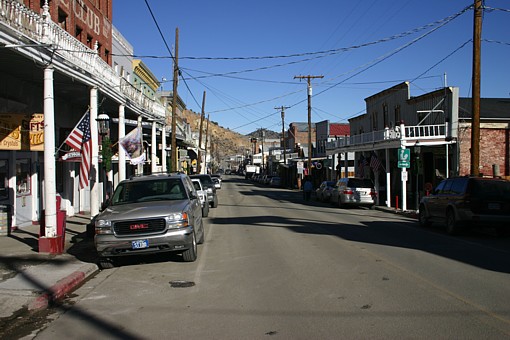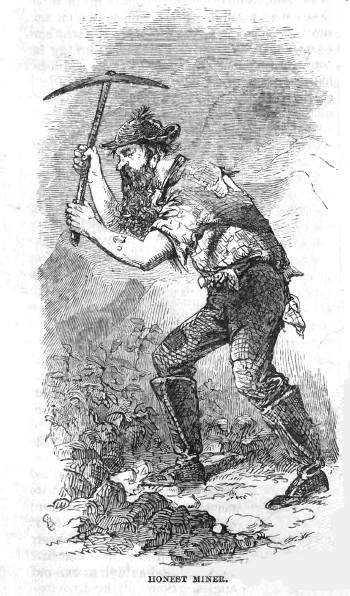The early stamp mills were very inefficient and a large amount of mercury was lost into the Carson River. They didnít even consider the toxicity of mercury as an issue to be concerned about, either for the mill employees or the environment. Much was lost into the Carson River. Modern mining is much more efficient and hardly causes any emission of pollutants to the environment, but it is interesting to consider the old operations, as there have been many stories of mercury and amalgam finds along the Carson river over the years. Here is an early day description of the problem as they saw it: The divisibility of mercury, and also of silver and gold, as shown by the milling operations conducted in Nevada, is incomprehensibly great, and would seem to be almost unlimited ; particularly in the case of the metal first named.
A globule of mercury may be divided until no longer visible to the naked eye, and, indeed, until scarcely visible under a microscope, and yet even the most minute subdivision shall be found to contain both gold and silver. How infinitesimally small, then,' must be the particles of silver and gold contained in one of these almost invisible and immeasurable globules of mercury! In regard to the remarkable divisibility of the precious metals, the following instance may be given in illustration : The superintendent of a water mill on the Carson River, when working for a considerable length of time a silver ore in which gold values largely predominated, used every precaution to guard against loss. In addition to the usual settling-tanks, he caused to be dug in the ground a number of large pits, into which the waste water flowed after leaving the tanks.
After leaving these pits, the water passed off in a small flume, and to the eye appeared as clear as the water of the purest mountain stream. For the sake of experiment, the superintendent coated a copper bowl with mercury, and placed it in such a position that the water from the .flume should fall into it. He also placed in the flume, below the bowl, some copper riffles, properly coated with mercury. Although the water passing through the flume appeared to be perfectly clear, yet at the end of three months the bowl and riffles were cleaned up and over $100 in amalgam was obtained. This mill is driven by water taken from the Carson River, and carried for a considerable distance through a large wooden flume. At one time it became necessary to shut off the water, for the purpose of repairing this flume. In making the repairs it was found that in many places that the heads of the nails driven into the bottom of the flume were thickly coated with amalgam. Within a distance of about three rods along the flume, the workmen engaged in making repairs collected over an ounce of amalgam. The water flowing through the flume was taken from the river, below a number of large mills, and, though far from being clear, would never have been suspected to contain floating mercury in such quantity as to form collections of amalgam on the heads of iron nails. In order that mercury may amalgamate with iron, the iron must be scratched or polished while immersed in the mercury; it will therefore be seen that much amalgam must have passed by before the accidental occurrence of the conditions under which the collection of amalgam on the heads of the nails could begin. As a beginning, a passing pebble must have pricked through a globule of mercury just at the moment when it was rolling over the head of a nail. By a succession of these accidental collisions the head was finally covered with mercury, and the collection of amalgam then went on rapidly.
As further evidence that mercury in considerable quantities floats in the water of flumes and streams, below reduction works, in a state of invisible division, and yet carries with it the precious metals, I may give an additional instance. At a mill on the Carson River one of the workmen required a piece of copper. Remembering to have seen some old sheets of that metal lying near the waste-gate of the flume, through which water was brought to the wheel of the mill, he went to the spot and hauled them out of a puddle in which they were lying. Much to his surprise he found the sheets heavily coated with amalgam and so eaten up by mercury that they were as thin as writing paper. The water pouring out through the waste-gate had a fall of about fifteen feet. It did not fall directly upon the copper plates, but in such a way as to keep them constantly splashed and wet. The plates had lain where they were found four or five years. Over a pound of amalgam was scraped off them.
It would seem that in these striking instances of the unsuspected floating away of the precious metals there is for mill men food for reflection, and for inventors a field of profit and distinction. Just what becomes of all the mercury used in the reduction- works of Nevada is a question which has never yet been fully and satisfactorily answered. Much floats away with the water flowing from the mills ; but it cannot be that the whole of the immense quantities used is lost in that way. Mercury in great quantities is constantly being taken into the State, and not an ounce is ever returned. When it has been used in the amalgamation of a batch of ore, it is taken to the amalgamating-pans, and is used over and over again until it has disappeared.
Whether it may float away with the water used in amalgamating, or is lost by evaporation while in the hot-bath of the steam-heated pans, there must be a vast amount of the metal collecting somewhere, as it is a metal not easily destroyed. In case it is lost by evaporation it must condense and fall to the ground somewhere near the works in which it is used, and if it floats away in the water it must eventually find a resting place on the bottom of the stream in which it is carried away. It is an axiom among mill men that "wherever mercury is lost, silver is lost" therefore there must be a large amount of silver lost, as we shall presently see.
The monthly amount of mercury used by he many mills working on the Comstock ores alone averaged 800 flasks, of 76 pounds each; or 61,200 pounds per month. This in one year would amount to 734,400 pounds of mercury that go somewhere, and counting backwards for ten years shows 7,344,000 pounds that have gone somewhere either up the flue or down the flume. The quantity of mercury distributed monthly among the mills shows just how much is lost per month. None is sold or sent out of the country in or with the bullion ; therefore, if there were no loss, the mills would never want any more mercury than enough to give them their first start, as the same lot could be used over and over again, ad infinitum.
Return
to The Nevada Mining Rush Page:
Nevada Gold Rush Mining History


